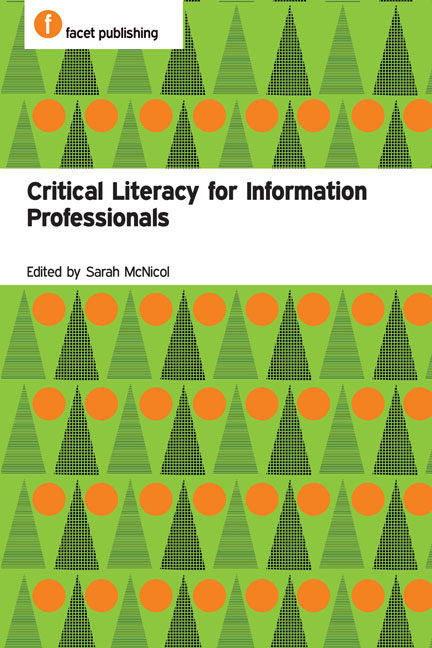Book contents
- Frontmatter
- Contents
- Contributors
- Introduction
- PART 1 THEORIES OF CRITICAL LITERACY
- 1 Renegotiating the place of fiction in libraries through critical literacy
- 2 Death of the author(ity): repositioning students as constructors of meaning in information literacy instruction
- 3 Reading health-education comics critically: challenging power relationships
- 4 Reframing librarians’ approaches to international students’ information literacy through the lens of New Literacy Studies
- 5 Using new literacies to discuss disability in the library
- 6 ‘Anyone can cook’: critical literacy in the workplace
- 7 Social justice, adult learning and critical literacy
- PART 2 CRITICAL LITERACY IN PRACTICE
- Further information
- Index
5 - Using new literacies to discuss disability in the library
from PART 1 - THEORIES OF CRITICAL LITERACY
Published online by Cambridge University Press: 08 June 2018
- Frontmatter
- Contents
- Contributors
- Introduction
- PART 1 THEORIES OF CRITICAL LITERACY
- 1 Renegotiating the place of fiction in libraries through critical literacy
- 2 Death of the author(ity): repositioning students as constructors of meaning in information literacy instruction
- 3 Reading health-education comics critically: challenging power relationships
- 4 Reframing librarians’ approaches to international students’ information literacy through the lens of New Literacy Studies
- 5 Using new literacies to discuss disability in the library
- 6 ‘Anyone can cook’: critical literacy in the workplace
- 7 Social justice, adult learning and critical literacy
- PART 2 CRITICAL LITERACY IN PRACTICE
- Further information
- Index
Summary
Introduction
While most libraries in the United States are compliant with the Americans with Disabilities Act (ADA), they are not necessarily accessible enough, or accessible at all, to those with disabilities, even when the buildings conform to the law. The ADA is a national law in the US that seeks to create more equal opportunities and treatment of people with disabilities. Codified within the law are requirements such as that all public buildings should have accessible entrances and bathrooms. While it is easy to say that libraries should make more efforts to provide services for people with disabilities and different access needs, in this time of economic uncertainty, all departments in the library have multiple competing priorities and a dearth of funding. Even if funding were not a major issue, competing priorities certainly are. The prevailing unspoken attitude tends to be that as long as the library is accessible for most people and is at least ADA compliant, than accessibility for all is not a tier-one priority. This chapter explores how new literacies can play a role in challenging such complacency and improving library access for people with disabilities. Librarians tend to be a forward-thinking group of people when it comes to technology; they are often early adopters and are used to considering ways in which technology can improve access to information. From here, this chapter argues, it is a relatively small step to using new literacies to change the very way that we think about accessibility.
The chapter starts with an overview of disability issues in relation to library provision. It then examines how the new literacies required to interact with digital media and, in particular, Lankshear and Knobel's (2006) notion of ‘mindsets’, might be a means to challenge prevailing attitudes. Building on this theory, a number of practical approaches are described. These include both general suggestions that might apply to a range of disabilities and examples of methods suited to particular conditions.
- Type
- Chapter
- Information
- Critical Literacy for Information Professionals , pp. 57 - 64Publisher: FacetPrint publication year: 2016



